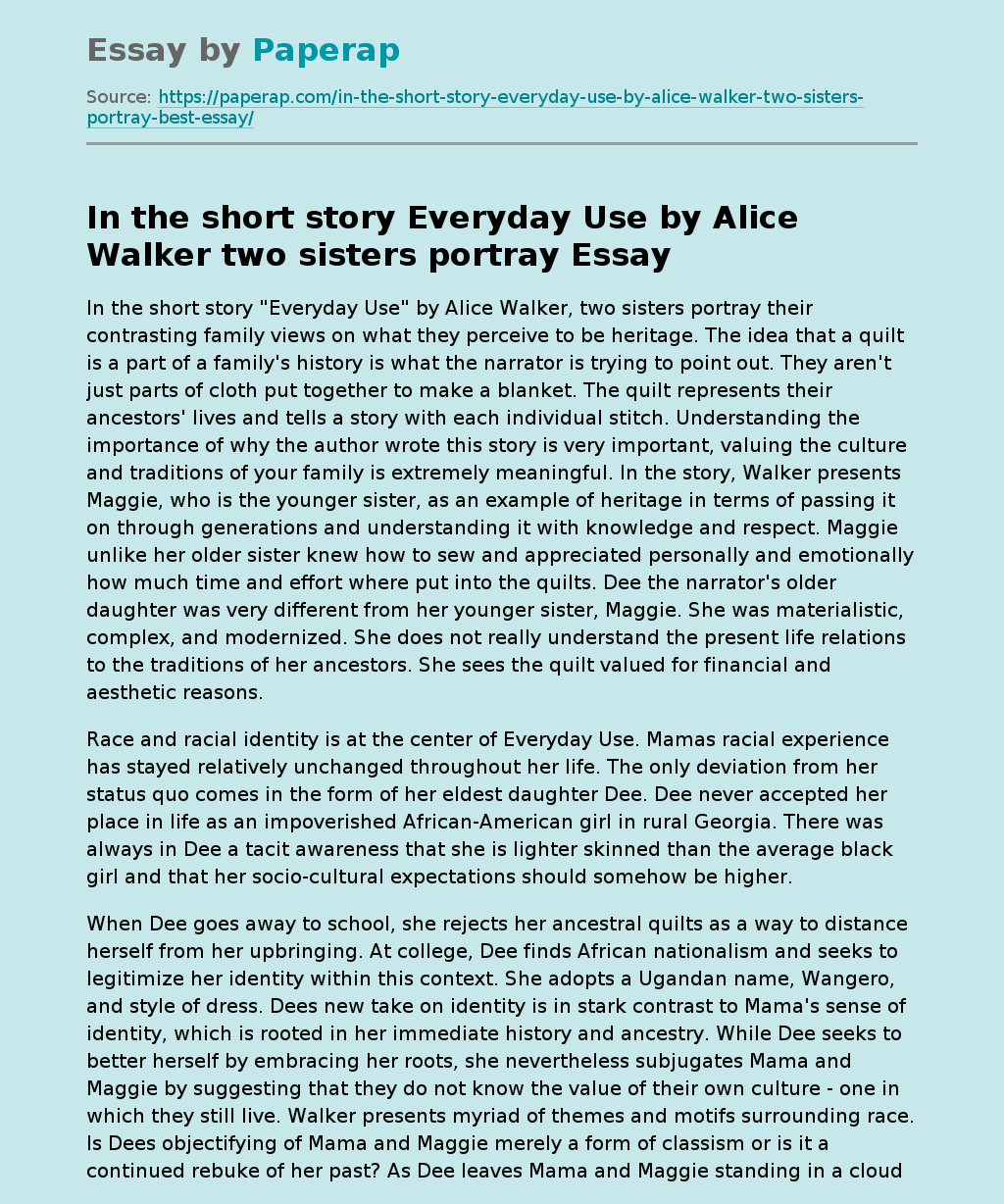In the short story Everyday Use by Alice Walker two sisters portray
In the short story “Everyday Use” by Alice Walker, two sisters portray their contrasting family views on what they perceive to be heritage. The idea that a quilt is a part of a family’s history is what the narrator is trying to point out. They aren’t just parts of cloth put together to make a blanket. The quilt represents their ancestors’ lives and tells a story with each individual stitch. Understanding the importance of why the author wrote this story is very important, valuing the culture and traditions of your family is extremely meaningful.
In the story, Walker presents Maggie, who is the younger sister, as an example of heritage in terms of passing it on through generations and understanding it with knowledge and respect. Maggie unlike her older sister knew how to sew and appreciated personally and emotionally how much time and effort where put into the quilts. Dee the narrator’s older daughter was very different from her younger sister, Maggie.
She was materialistic, complex, and modernized. She does not really understand the present life relations to the traditions of her ancestors. She sees the quilt valued for financial and aesthetic reasons.
Race and racial identity is at the center of Everyday Use. Mamas racial experience has stayed relatively unchanged throughout her life. The only deviation from her status quo comes in the form of her eldest daughter Dee. Dee never accepted her place in life as an impoverished African-American girl in rural Georgia. There was always in Dee a tacit awareness that she is lighter skinned than the average black girl and that her socio-cultural expectations should somehow be higher.
When Dee goes away to school, she rejects her ancestral quilts as a way to distance herself from her upbringing. At college, Dee finds African nationalism and seeks to legitimize her identity within this context. She adopts a Ugandan name, Wangero, and style of dress. Dees new take on identity is in stark contrast to Mama’s sense of identity, which is rooted in her immediate history and ancestry. While Dee seeks to better herself by embracing her roots, she nevertheless subjugates Mama and Maggie by suggesting that they do not know the value of their own culture – one in which they still live. Walker presents myriad of themes and motifs surrounding race. Is Dees objectifying of Mama and Maggie merely a form of classism or is it a continued rebuke of her past? As Dee leaves Mama and Maggie standing in a cloud of dust clutching their quilts, it is clear the idea of racial identity is complex and inherently both personal and political.
Perhaps the biggest irony in the story is Dees rejection of her real heritage for a broader, yet limited, cultural ideal. By juxtaposing Dee with her sister and mother, Walker suggests Dee’s new identity is simply a superficial rebranding of herself. She strives to wear her heritage like a unique treasure but ends up shrouded in imitation. Dee reinvents herself using a mixture of academic and romantic ideas of pre-colonial Africa, but her flamboyant clothing combined with her gaudy jewelry make Wangero look more like an African caricature rather than an authentic attempt at a cultural shift in attitude. In swapping her name – a familial namesake – for a Ghanaian one, she opts to identify with a less specific aspect of her heritage. Dee’s appreciation for items in Mama’s home as artifacts of her heritage is similarly misguided. She insists a quilt, once viewed as a symbol of her family’s poverty, is now imbued with the spirit of her ancestry. But Dee wants to fetishize these objects rather than put them to “everyday use”, rejecting the active heritage around her. These items are an extension of her real heritage; having evolved with the family rather than become quaint reminders of a life Dee put behind her when she left for school. Her notion of heritage is one that is past – even though Mama and Maggie and their way of life are still very much present and valid. Heritage is, thus, both past and present, and encompasses one’s personal and ancestral history.
Everyday Use is a story about a family homecoming, and the dynamics between the three women provide much of the narrative drama. Its narrator, Mama, reflects on her daughters and the circumstances of their upbringing while awaiting Dee’s return. Dee was the more difficult child, but Mama nevertheless loved her. Maggie is scarred, but loving, respectful of her family and heritage. Mama believes that family ties are indelible, even despite Dee’s dismissal of her childhood and direct ancestry. Named after a long line of Dees, Wangero’s rejection of her birth name is a symbol for the rejection of her family – even if that rejection is an attempt to connect to a larger history. To Mama and Maggie, however, the people you come from and who raised you matter more than a legacy you read about in books. Like any family, Mama’s family is fraught with drama and history, complexity and contradiction.
In the short story Everyday Use by Alice Walker two sisters portray. (2019, Dec 04). Retrieved from https://paperap.com/in-the-short-story-everyday-use-by-alice-walker-two-sisters-portray-best-essay/

